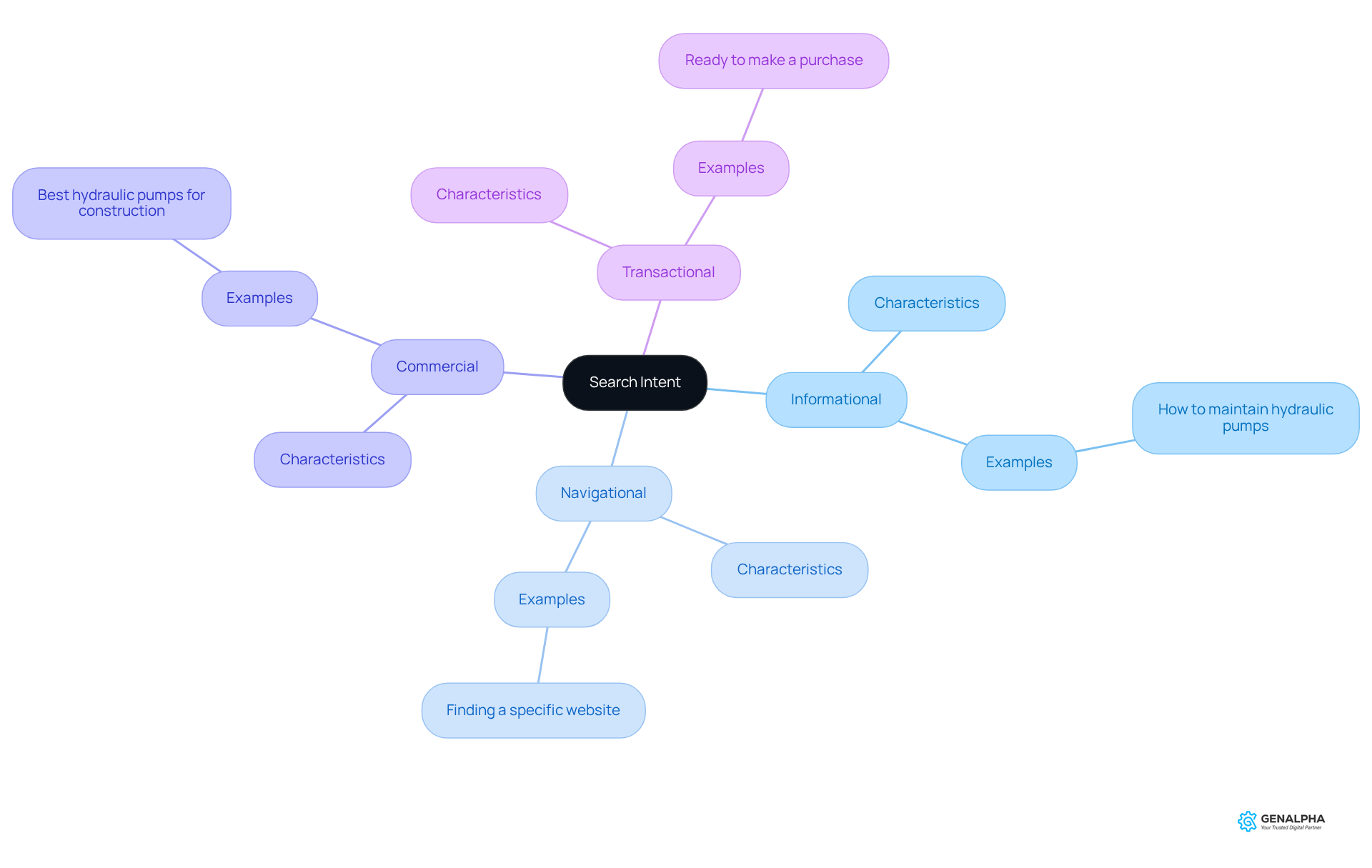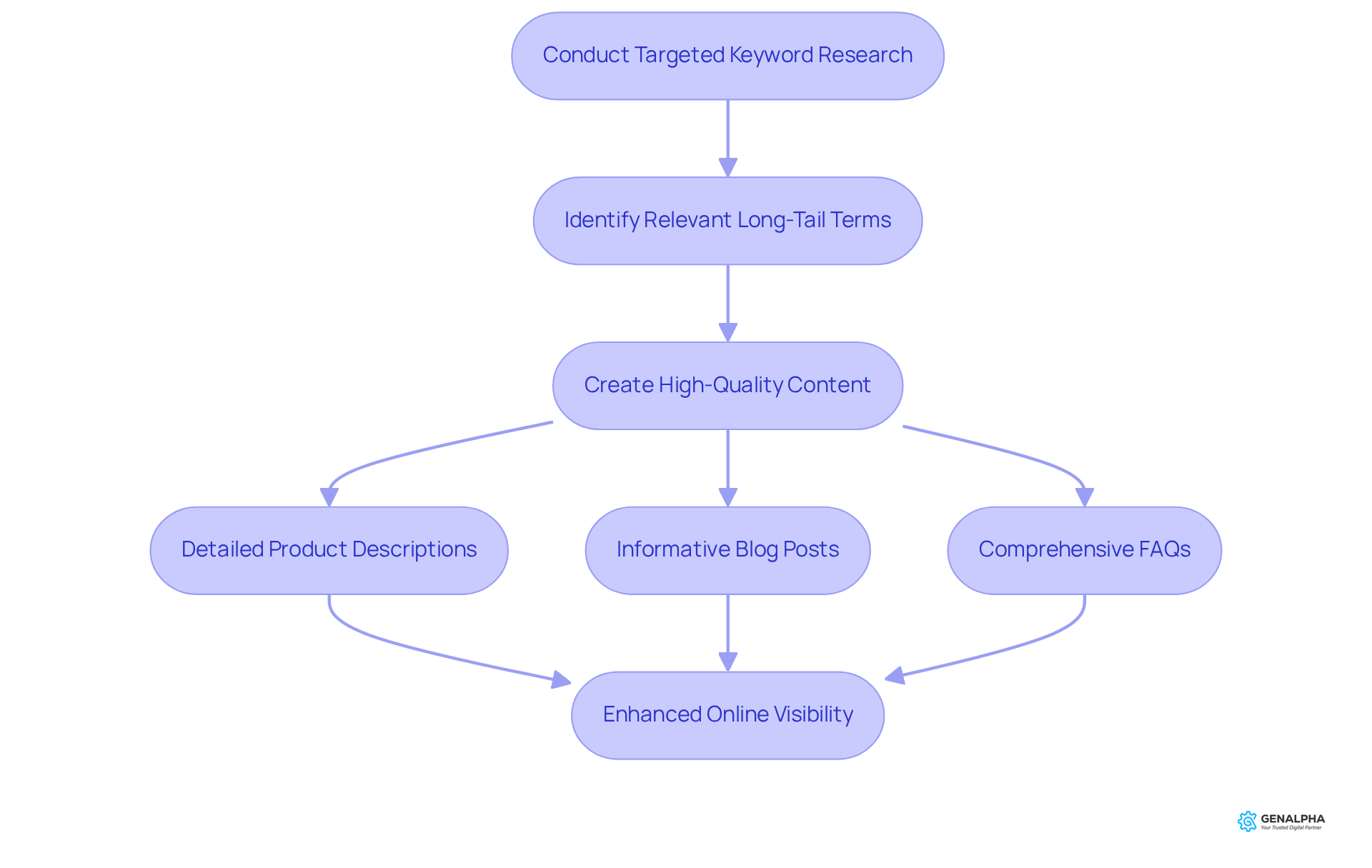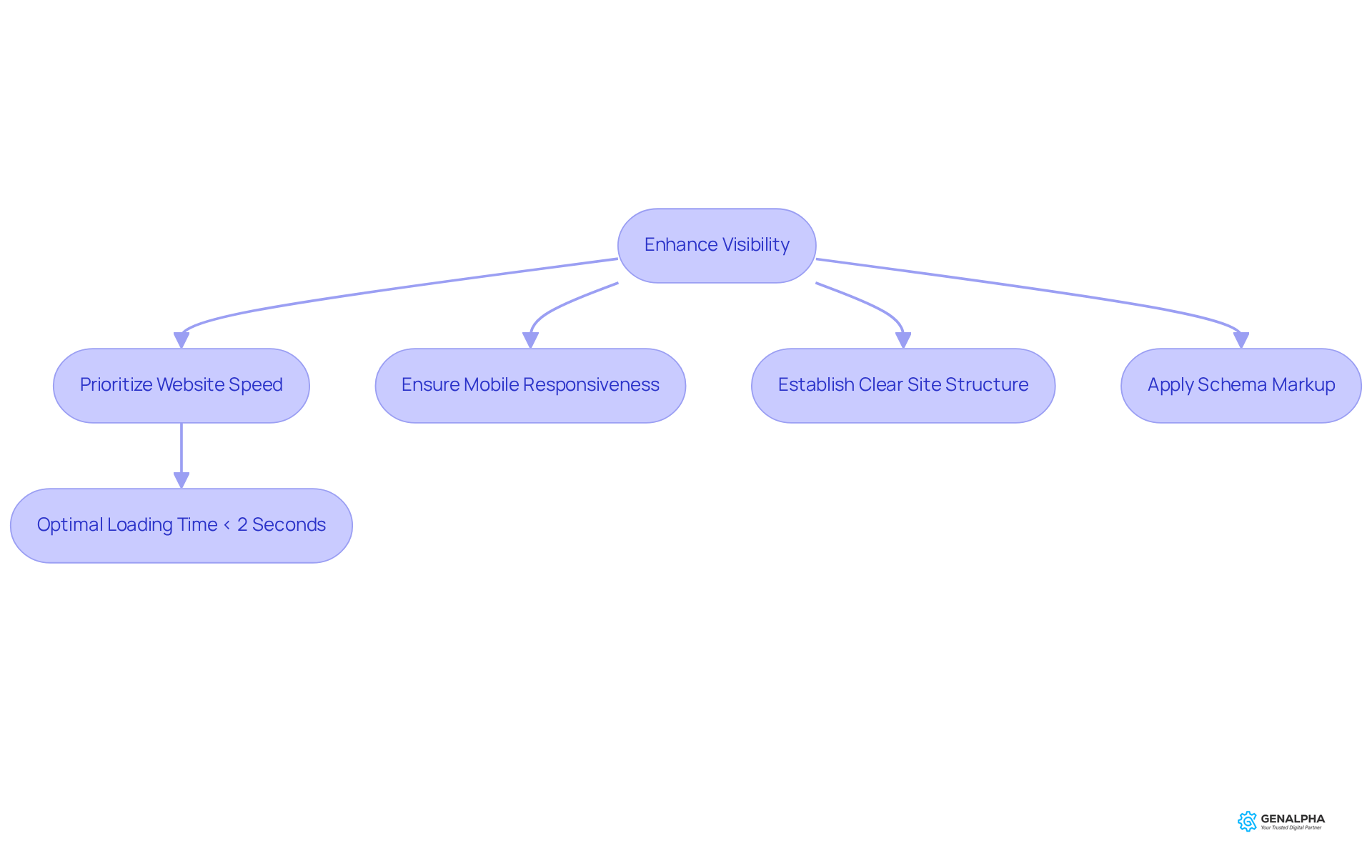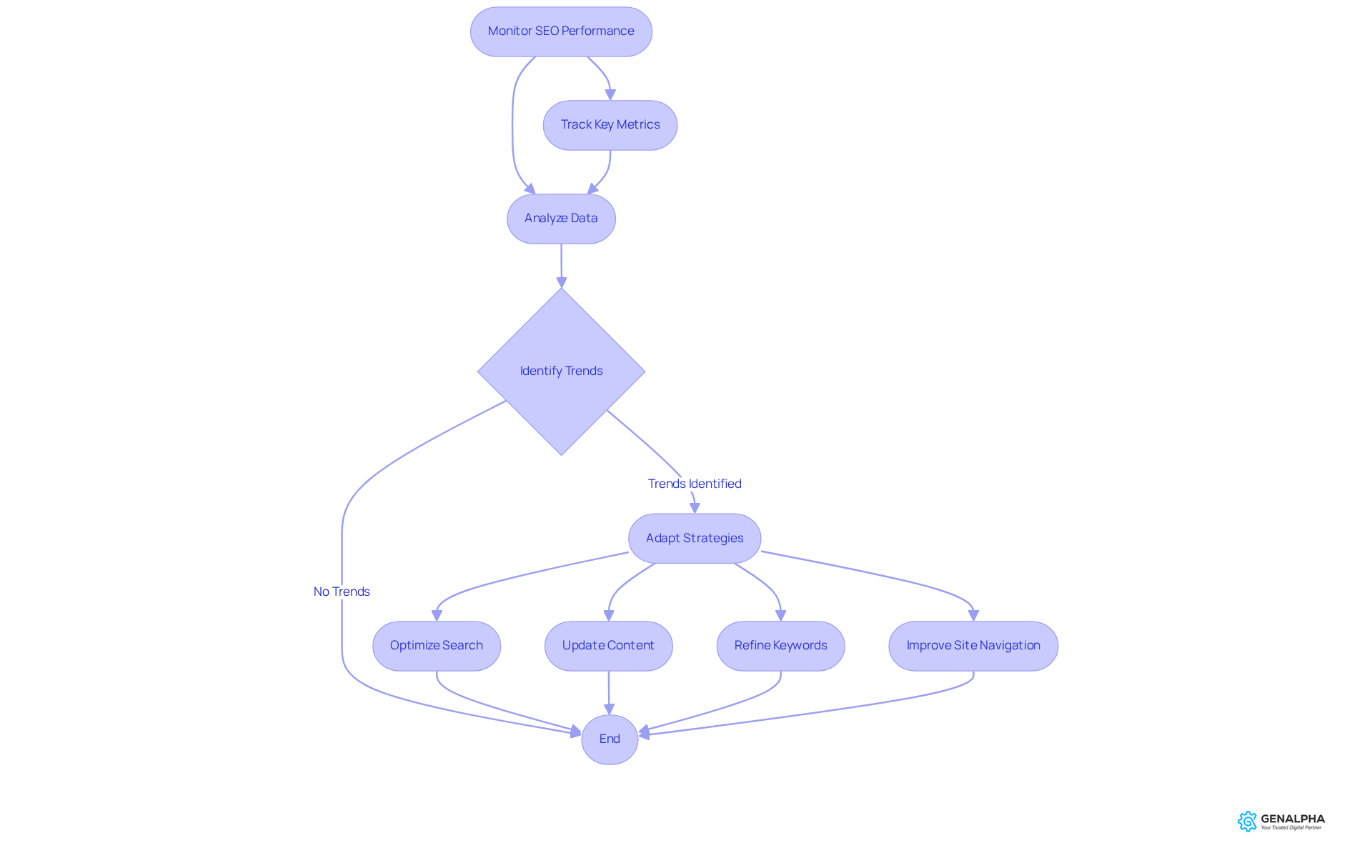Overview
In the competitive landscape of equipment manufacturing, optimizing search strategies is essential for success. Understanding search intent is crucial, as it allows manufacturers to align their content with what potential buyers are actively seeking. Conducting targeted keyword research enables manufacturers to identify the specific terms that resonate with their audience, enhancing the relevance of their offerings.
Implementing technical SEO best practices is another vital strategy. By ensuring that websites are structured effectively and perform well in search engine rankings, manufacturers can significantly boost their online visibility. Monitoring performance analytics provides valuable insights into user behavior, allowing for continuous improvement and adaptation of strategies.
Evidence shows that tailoring content to specific user intents and utilizing long-tail keywords can lead to marked improvements in engagement and conversion rates. This approach not only enhances online presence but also fosters stronger connections with potential buyers. To maximize these strategies, manufacturers must take proactive steps in refining their search optimization efforts and actively engage with their audience through relevant and insightful content.
Introduction
Understanding the nuances of search intent is paramount for equipment manufacturers aiming to elevate their online presence. The digital landscape is rife with challenges, and manufacturers must delve into the specific needs and motivations of their target audience. By tailoring their content and strategies to effectively meet these demands, they can enhance their visibility and drive conversions.
However, in a rapidly evolving environment, how can they ensure their approach remains relevant and impactful? This article unveils key strategies that equip manufacturers with the essential tools to optimize their search efforts, boost visibility, and ultimately thrive in a competitive market.
Understand Industry-Specific Search Intent
To effectively enhance queries, manufacturers must grasp the specific intents of their target audience. This entails categorizing queries into four primary types:
- Informational
- Navigational
- Commercial
- Transactional
Informational queries, such as 'how to maintain hydraulic pumps,' reveal a thirst for knowledge, whereas navigational queries are aimed at locating a specific site. Commercial queries, like 'best hydraulic pumps for construction,' indicate product research, and transactional queries demonstrate a readiness to purchase.
Recent statistics reveal that , highlighting the necessity of tailoring content to these intents. As content marketer Carlos Silva asserts, understanding and optimizing search for intent is vital for SEO success.
By crafting effective landing pages with clear calls to action (CTAs) for transactional queries, producers can significantly boost engagement and conversion rates. However, misapplying intent strategies can result in missed opportunities; for instance, neglecting to address users' specific needs may lead to diminished engagement.
Including case studies that illustrate successful implementations of search intent strategies can further underscore the effectiveness of this approach, ensuring that producers connect with potential buyers throughout the purchasing journey.

Conduct Targeted Keyword Research and Content Development
Enhancing online visibility is a critical challenge for equipment manufacturers. Conducting targeted keyword research is essential to address this issue effectively. By utilizing tools such as Google Keyword Planner or SEMrush, businesses can identify relevant long-tail terms that potential customers are actively seeking. For instance, focusing on specific phrases like 'heavy-duty construction equipment rental' rather than broad terms can significantly improve performance in search results. Research indicates that long-tail phrases convert at rates 2.5 to 5 times greater than generic terms, with 21% higher click-through percentages in Google Ads campaigns. Moreover, long-tail terms convert at rates three times greater than generic local inquiries, positioning them as a strategic option for B2B eCommerce.
Once relevant terms are identified, manufacturers should create high-quality content that aligns with these keywords. This encompasses:
- Detailed product descriptions
- Informative blog posts
- Comprehensive FAQs
Such content not only enhances search rankings but also plays a role in optimizing search and establishes the manufacturer as an authority in their field. In fact, pages optimized for long-tail phrases exhibit 2.5 times higher time-on-page and 3.7 times lower bounce rates compared to those targeting head terms. Additionally, pages tailored for long-tail keywords generate 37% more qualified leads at a 24% lower acquisition cost than broad term strategies. By prioritizing long-tail keywords and crafting targeted content, manufacturers can effectively drive more traffic to their websites and enhance customer engagement through optimizing search.

Implement Technical SEO Best Practices for Enhanced Visibility
To enhance visibility, manufacturers face significant challenges that must be addressed with . Prioritizing website speed, ensuring mobile responsiveness, and establishing a clear site structure with effective internal linking are crucial. The optimal loading time for a website is quicker than two seconds, with a maximum threshold of three seconds. This not only greatly enhances user experience but also reduces abandonment rates, as 53% of mobile users leave sites that take longer than three seconds to load.
Moreover, applying schema markup can assist search engines in comprehending content more effectively, leading to improved visibility in search results. Regular performance audits using tools like Google Search Console are essential for identifying and addressing technical issues that may impede site performance. These audits help maintain a well-optimized website, ensuring that it meets user expectations. For instance, one producer reported a 50% enhancement in homepage exit percentages after transitioning to a simplified theme. This underscores the importance of streamlined website design in improving user engagement.
By focusing on these critical elements, equipment manufacturers can enhance their search rankings while optimizing search to provide a more satisfying experience for their users. Take action now to implement these strategies and witness the positive impact on your online presence.

Monitor Performance and Adapt Strategies Based on Analytics
Monitoring SEO performance is crucial for manufacturers aiming to thrive in a competitive landscape. Utilizing tools such as Google Analytics and Google Search Console enables the tracking of key metrics, including:
- Organic traffic
- Bounce percentages
- Conversion figures
By regularly analyzing this data, manufacturers can identify trends and pinpoint areas for improvement. For example, a high bounce rate on a particular product page may suggest that the content fails to meet user expectations. Adapting strategies based on these insights—such as:
- Optimizing search
- Updating content
- Refining keywords
- Improving site navigation
Empowers manufacturers to continuously enhance their SEO efforts and better serve their customers. Take action now to optimize your SEO strategy and drive meaningful results.

Conclusion
Optimizing search for equipment manufacturers presents significant challenges that necessitate a comprehensive grasp of industry-specific search intent, strategic keyword research, technical SEO best practices, and continuous performance monitoring. By concentrating on these essential areas, manufacturers can significantly boost their online visibility and effectively engage with their target audience.
Key strategies include categorizing search queries into four primary types—informational, navigational, commercial, and transactional—allowing for tailored content that addresses users' distinct needs. Moreover, targeted keyword research highlights the critical role of long-tail keywords, which greatly enhance engagement and conversion rates. Implementing technical SEO practices, such as optimizing website speed and ensuring mobile responsiveness, is vital for delivering a seamless user experience. Finally, utilizing analytics tools to monitor performance enables manufacturers to refine their strategies based on real-time data, fostering continuous improvement.
The importance of these strategies is paramount. As competition within the manufacturing sector escalates, adopting effective SEO practices becomes crucial for achieving success. Manufacturers are urged to take proactive measures in implementing these strategies, ultimately driving meaningful results and solidifying a robust online presence. By embracing these best practices, they will not only elevate their visibility but also cultivate enduring connections with potential customers throughout their purchasing journey.
Frequently Asked Questions
What are the four primary types of search intent that manufacturers should understand?
The four primary types of search intent are informational, navigational, commercial, and transactional.
What is an example of an informational query?
An example of an informational query is "how to maintain hydraulic pumps," which indicates a desire for knowledge.
What does a navigational query aim to achieve?
A navigational query aims to locate a specific site.
What type of query indicates product research?
A commercial query, such as "best hydraulic pumps for construction," indicates product research.
How can manufacturers boost engagement and conversion rates for transactional queries?
Manufacturers can boost engagement and conversion rates by crafting effective landing pages with clear calls to action (CTAs) for transactional queries.
What is the significance of tailoring content to search intent?
Tailoring content to search intent is vital for SEO success, as it helps meet the specific needs of the target audience.
What can happen if manufacturers misapply intent strategies?
Misapplying intent strategies can result in missed opportunities and diminished engagement if users' specific needs are neglected.
How can case studies be beneficial in understanding search intent strategies?
Including case studies that illustrate successful implementations of search intent strategies can underscore the effectiveness of this approach and help producers connect with potential buyers throughout the purchasing journey.




